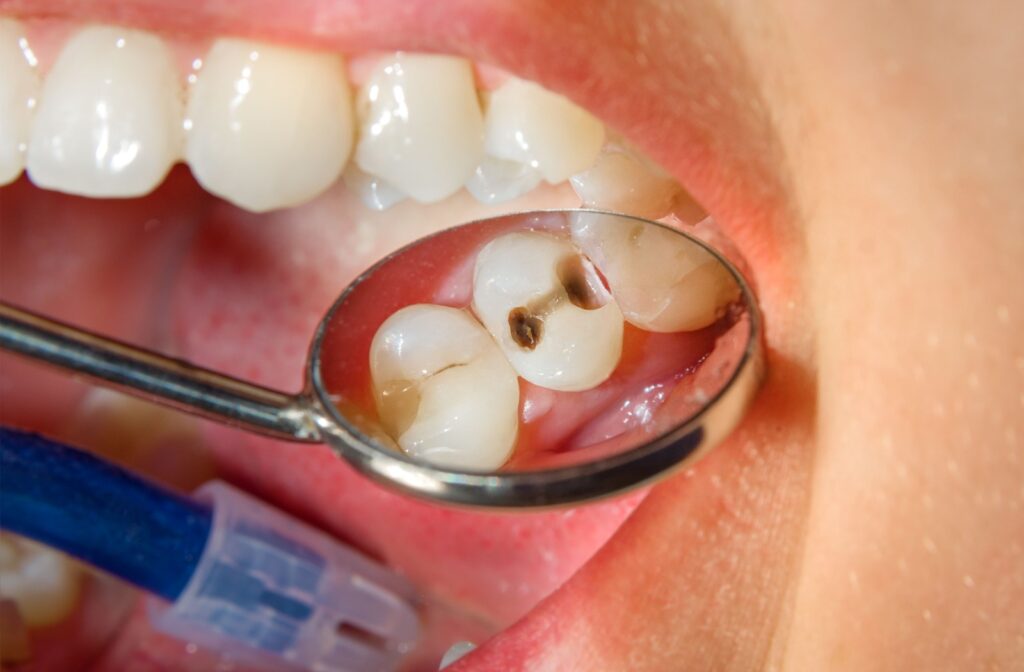Cavities can be uncomfortable but can be easily treated. Understanding the process of cavity treatment can relieve some of the anxiety that may come with a visit to the dentist.
How long it may take to fill a cavity can depend on various factors such as size, depth, location, type of filling, and your dentist’s protocol. It can take approximately 30 minutes—1 hour to fill a cavity.
In this post, we’ll explain everything you need to know about how long it takes to fill a cavity and what factors might influence timing.
What Is a Cavity?
In dental terms, a cavity refers to a defect in the enamel and/or dentin that develops due to tooth decay. This decay results from the acids produced when the sugars in food and drink interact with the bacteria in dental plaque.
How Cavities Are Harmful
Cavities can lead to significant oral health problems if left untreated. The initial stages of tooth decay may not cause any symptoms, making it easy for cavities to grow undetected. Over time, these cavities can penetrate deeper into the tooth, and if they reach the delicate nerve and blood vessels within the pulp chamber, it can result in requiring root canal therapy or an extraction.
If left untreated, cavities can grow larger and affect deeper layers of your teeth. Early detection and treatment are imperative to prevent more serious issues and to keep your smile healthy.
Signs You May Have a Cavity
Identifying the presence of a cavity early on can be the key to preventing more extensive dental issues. There are several signs and symptoms to watch for, which may indicate the onset of tooth decay. These may include:
- Tooth sensitivity: You might start to experience discomfort or sharp pain when your teeth are exposed to hot, cold, or sweet foods and drinks.
- Visible holes or pits in your teeth: In some cases, you might see a hole or pit in your tooth where the cavity has formed.
- Short-term sharp pain: If a tooth is stimulated by hot, cold, or pressure and you experience short-term pain, that can be a clear sign of a cavity.
- Pain when biting down: Cavities can cause short-term pain or short-term sensitivity when you bite down on food.
- Staining: Dark spots or white areas on the surface of your teeth can indicate the beginning of cavity formation. Changes in colour on your tooth are always suspicious and you should talk to your dentist.
- Bad breath: Persistent bad breath or a bad taste in your mouth can also be associated with cavities due to decay.
Long-term pain or spontaneous pain are more likely a more serious problem, requiring root canal therapy or extraction. This is because the decay has entered the pulp chambered and has started an infection and associated inflammation.
Considerations for Cavity Fill Time
Several factors can determine how long the cavity-filling process will take, including:
- Size and depth of the cavity: Smaller cavities generally require less time to prepare and fill than larger ones.
- Location of the cavity: Teeth that are harder to reach, like back teeth, may take more time to treat.
- Type of filling material: Different materials, such as amalgam or composite, have distinct preparation and curing times.
- Your dentist’s protocol: Individual dentist’s speed, expertise, and office protocols can influence the duration of the procedure.

Typical Procedures with Approximate Timelines
Here’s an estimated timeline of what you might expect during a typical cavity-filling appointment:
- Preparation (10-20 minutes): First, your dentist will numb the affected area with a local anesthetic for comfort throughout the procedure and they may decide a rubber dam is necessary.
- Removing the decay (5-20 minutes): Your dentist will use various tools to remove decayed material from the tooth. The length of this step depends on the extent of the cavity.
- Filling the tooth (5-20 minutes): After cleaning the cavity of bacteria and debris, the dentist will fill it with a material chosen before the procedure.
- Polishing (5-10 minutes): To finish, the dentist will polish the filled area to smooth out rough edges and make it smooth to your tongue.
- Adjust your bite (5-10 minutes): The dentist will check your bite to make sure it is even throughout.
The entire procedure typically takes between 30 minutes to an hour for a simple cavity. More complex cases could take longer, especially if there are multiple cavities, on multiple teeth, or other issues to address.
When You Need a Filling
While the thought of filling a cavity may not be pleasant, the procedure is relatively quick, thanks to modern techniques and materials. Remember, the best way to reduce your time in the dentist’s chair is to maintain diligent oral hygiene and have regular check-ups.
Take the first step towards a healthier smile today—schedule your dental visit at Southgate Dental Centre to address those cavities before they become more problematic. Your teeth will thank you!



